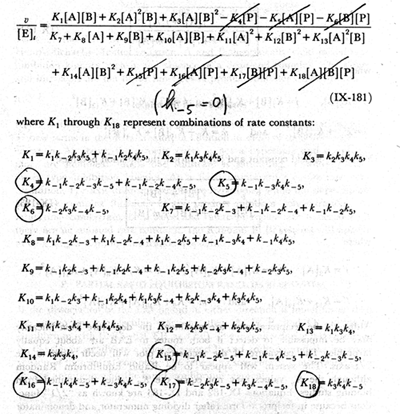

| BioKin, Ltd. |
| Tools |
| King-Altman |
| Submit |
| Examples |
| Theory |
| Sitemap |
| Contact |
 |
| Theoretical Notes |
| Derivation of steady-state rate equations using the King-Altman method |
Update[May 2015]
TheoryBy design, this online tool derives the final rate equation in the same general form as is shown in Equation IX-181 (Bi Uni Random mechanism) on page 647 in Segel's Enzyme Kinetics:
In other words, no attempt is made to further manipulate groups of rate constants (K1, K2, K3, etc.) in order to produce Michaelis constants and inhibition constants. The reason for this is given on page 647 in Segel's book: "The equation does not describe a hyperbola and, theoretically, the reciprocal plots are not linear, unless one substrate is saturating. [...] The groups of rate constants cannot be combined into convenient kinetic constants [Michaelis constants and inhibition constants]." This also true for the Bi Bi Random mechanism (Segel, p. 649) and other relatively complex branched mechanisms. In all these cases the Michaelis constants cannot be defined either formally or phenomenologically ("concentration of substrate at which half-saturating reaction rate is reached"). Indeed, the substrate saturation curve in these complex cases is not a rectangular hyperbola, and for this reason it does not make sense to speak about "half-maximum velocity", at least not in the same sense that is applicable to the simple Michaelis-Menten mechanism. In fact, Segel (p. 659) gives a nice overview of the great variety of substrate saturations curves that arise in the case of the Bi Bi Random mechanism, depending on the relationship between the values of elementary rate constants. The illustrations in Segel's Figure IX-37 include the following cases of non-hyperbolic kinetics:
|
 |



Thu May 16 16:21:32 2024
